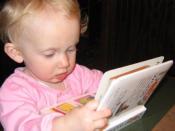Bonding and attachment is a falling in love process (Yvonne Bush 2001,
p. 20). When describing the words 'bonding and attachment' in reference to children, most people relate to the word 'mother' and not 'father'. Females have become more nurturant, person oriented and child centered, and males have become more competitive and work oriented (Risman 1986, p. 95). This summary will include the definitions of the terms bonding and attachment, the social consequences of theorising 'mothers' as central in infant and childcare and the implications of acceptance of bonding and attachment theories.
There is a difference in the term bonding and attachment. Bonding can be described as the loving commitment by a parent to meet and fulfill an infant's need (Vera Falhberg 1991 cited in Bush 2001, p.19). The word 'bonding' can be used in terms of gluing objects together so that it can connect, and hence can be seen as an 'emotional glue' which connects people together.
Bonding is the process of forming an emotional connection, which is attachment (Perry 2001). Attachment can be defined as the nature and quality of the relationship between an infant and a primary caregiver (Wiggins 2000). Attachment is also reciprocal, the enduring emotional tie between an infant and a caregiver (Fernandez 2010, p. 333).
History has placed a strong bias on the role of a mother and father as some historians believe that the role of the 'father' started decreasing from the time of the "advent of the Industrial Revolution in the mid- nineteenth century" (Parke & Sawin 1976) and because of this, the fathers role has become of less importance. However in recent times, women have taken more ownership in the workforce but even still, some mothers are unsure of the father's participation in care giving and are unwilling to allow...


